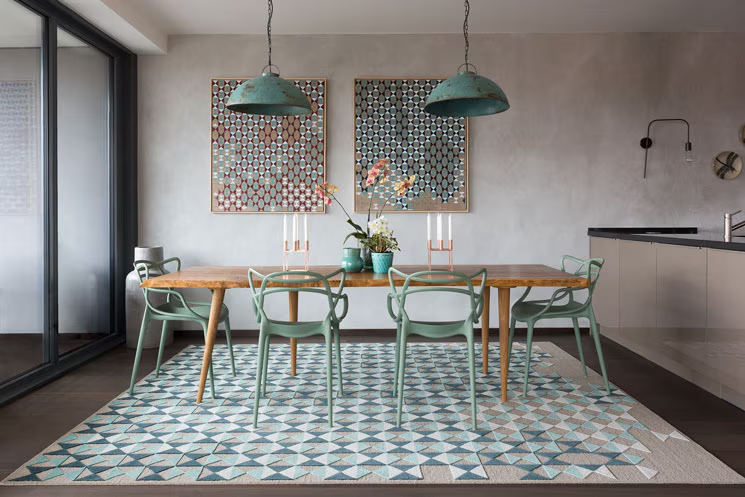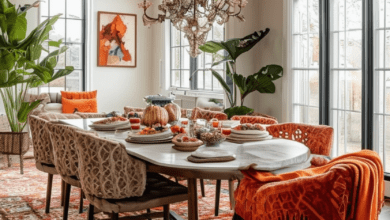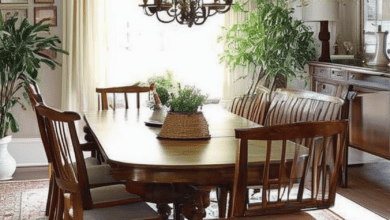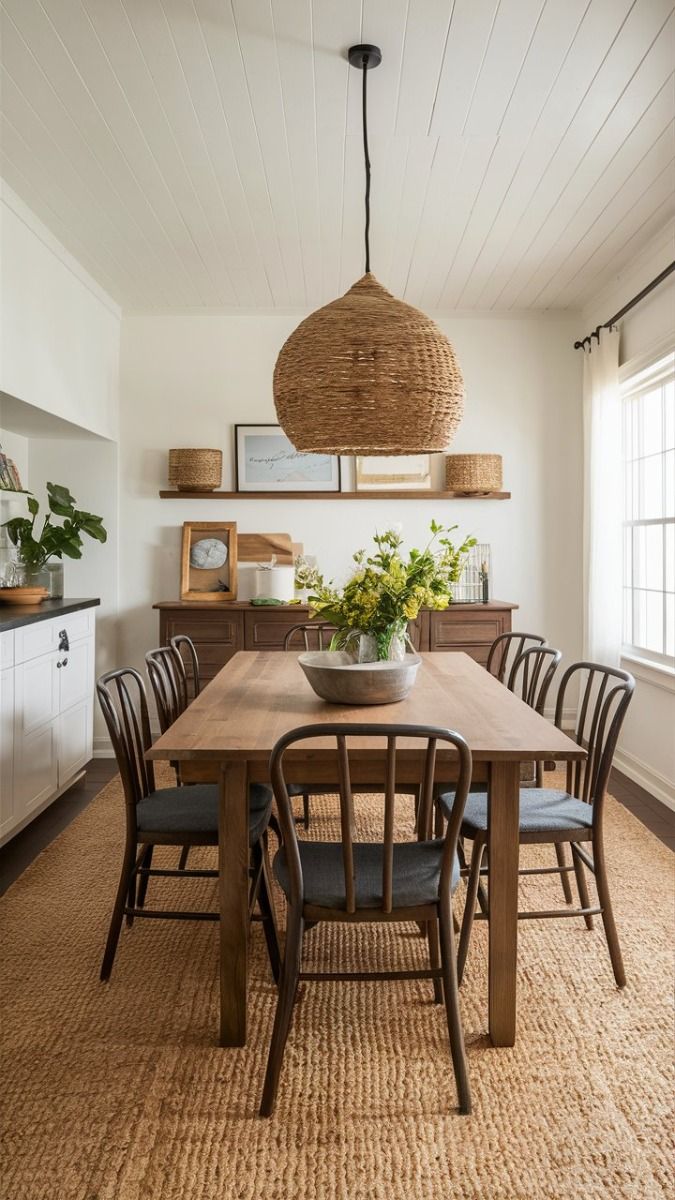
Dining Room Area Rugs: A Cozy Addition to Your Home
When it comes to turning a house into a cozy and welcoming home, it’s the small details that can make the most significant impact. One of these details is choosing the perfect area rug for your dining room, adding warmth, style, and personality to the space. Picture yourself surrounded by loved ones, enjoying good food and laughter while standing on a well-chosen rug that brings the whole room together. The right dining room rug not only enhances the room’s decor but also serves as a comfortable and inviting foundation for gatherings and conversations. In this guide, we’ll discuss how you can elevate your dining area with the perfect area rug, covering topics such as design, material, size, and more to help you create a stylish and welcoming space. Join us on this journey of exploration where color and texture combine to create a space perfect for culinary gatherings, making your dining room the heart of your home.
Understanding the Role of Area Rugs in Dining Spaces

Area rugs serve as an essential design element in dining spaces, offering both functionality and aesthetic appeal. They help to define the dining area and create a warm, inviting atmosphere for family and friends. When selected thoughtfully, rugs can enhance the overall decor by introducing color, texture, and pattern. Here are some functionalities that make area rugs indispensable in your dining area:
- Sound Absorption: Rugs help to muffle noise, contributing to a more intimate dining experience.
- Comfort: They provide a plush surface underfoot, making the dining experience more enjoyable.
- Protection: Area rugs safeguard your flooring from scratches and spills, acting as a barrier against potential damage.
- Visual Cohesion: A well-chosen rug can tie together various elements of the room, creating a harmonious look.
When selecting the ideal area rug for your dining space, consider the size, material, and design that best suit your needs. A rule of thumb is to opt for a rug that is large enough to accommodate the dining table and chairs, allowing the chairs to be pulled out comfortably without leaving the rug. Additionally, materials such as jute, wool, or synthetic fibers can be practical choices, as they often provide durability and ease of cleaning. Here’s a simple table showcasing the characteristics of different rug materials:
| Material | Durability | Maintenance |
|---|---|---|
| Wool | Highly Durable | Vacuum Regularly |
| Jute | Moderately Durable | Spot Clean |
| Synthetic | Very Durable | Easy to Wash |
Choosing the Right Size Area Rug for Your Dining Room

When it comes to selecting an area rug for your dining room, size is of utmost importance. A well-chosen rug not only enhances the aesthetics of your space but also defines the seating area, instilling a sense of unity. To begin with, consider the dimensions of your dining table. Ideally, your rug should extend at least 24 inches beyond the table’s edges on all sides. This allows for comfortable movement of chairs in and out without causing them to snag on the rug—a practical yet stylish choice.
Next, take into account the overall layout of your dining room. A good rule of thumb is to ensure that the rug accommodates all chairs when they are pulled out. Here are some quick tips to help determine the right size:
- Small Dining Area: A 5×8 feet rug could be perfect for a cozy space.
- Standard Dining Table: For a 6-8 person table, consider an 8×10 feet rug.
- Large Tables: An expansive 9×12 feet or larger for bigger settings.
Additionally, consider the shape of the rug in relation to the shape of your table. Rectangular tables often pair well with rectangular rugs, while round tables can look striking on round rugs. To help visualize your options, here’s a quick reference table:
| Table Shape | Recommended Rug Shape | Suggested Size |
|---|---|---|
| Rectangular | Rectangular | 8×10 feet or larger |
| Round | Round | 6 to 9 feet diameter |
| Square | Square | 6×6 feet, 8×8 feet |
Exploring Materials: Wool, Cotton, and Synthetic Options

When it comes to choosing the ideal area rug for your dining room, the material plays a crucial role in both aesthetic appeal and functionality. Natural fibers such as wool and cotton each offer distinct characteristics that can enhance your space. Wool is revered for its durability and natural stain resistance, making it a practical choice for high-traffic areas. It provides a soft, luxurious texture underfoot and holds dye beautifully, resulting in vibrant colors and intricate patterns. On the other hand, cotton rugs are lightweight, easy to maintain, and available in a plethora of styles and designs. They naturally impart a cozy, inviting feel, perfect for a relaxed dining atmosphere.
If you’re considering synthetic options, they come with their own set of advantages. Synthetic rugs, like those made of nylon or polyester, are often more affordable and can mimic the look of natural fibers while offering enhanced stain and fade resistance. Their low maintenance requirement and versatility make them suitable for families with children and pets. When selecting a rug, think about the texture, color palette, and how it aligns with your dining room’s overall style. The right material not only elevates the aesthetic but also contributes to the comfort and practicality of your space.
The Impact of Color and Pattern on Dining Room Aesthetics

Color and pattern play a pivotal role in defining the ambiance of a dining room. Choosing the right hues can dramatically transform the space, making it feel more inviting or elegant. For instance, warm tones like reds and oranges can stimulate appetite and conversation, while cool hues such as blues and greens create a calming effect, perfect for long dinners with family and friends. The patterns on area rugs, whether they are intricate geometric designs or soft, flowing florals, contribute significantly to the visual flow. They can draw the eye and guide guests seamlessly from one element of the room to another, enhancing the overall aesthetic.
When selecting an area rug, consider how the color and pattern interact with existing decorations. A vibrant, patterned rug can serve as a centerpiece, complementing neutral furniture, or it can add depth to a monotone color palette. Here are some combinations to consider:
- Bold geometric patterns with solid dining chairs
- Soft pastels to brighten dark wood tables
- Organic motifs to harmonize with natural materials
Integrating the right rug can also help delineate dining spaces in open floor plans. Observing the characteristics of your dining area can assist in choosing a rug that not only enhances style but also increases functionality.
Complementing Your Dining Table with Area Rug Shapes

When selecting an area rug to complement your dining table, the shape plays a pivotal role in enhancing both aesthetics and functionality. Round tables naturally pair well with round rugs, creating a soft, inviting focal point that encourages conversation. On the other hand, for squared or rectangular tables, opt for a rectangular or oval rug to maintain proportion and visual harmony. The conversation flows smoother, and the eye is naturally drawn to the table, making the dining area feel more cohesive.
Consider the size of the rug in relation to your dining furniture. A general rule of thumb is to ensure that the rug extends at least 24 inches beyond each side of the table when chairs are pulled out. This not only provides comfort for diners but also prevents those inevitable mishaps of chair legs catching the edges of the rug. When choosing colors and patterns, keep in mind a few key factors:
- Color Palette: Ensure the colors harmonize with your walls and furniture.
- Pattern: A bold pattern can add visual interest, while a subtle one can offer a more understated elegance.
- Material: Choose materials that are easy to clean, especially in a dining area.
Navigating Texture: Balancing Softness and Durability

When selecting a dining room area rug, the interplay between softness and durability becomes paramount. A well-chosen rug can elevate the aesthetic of your dining space while also standing up to the challenges of everyday life. Soft fibers like wool or silk provide a plush feel underfoot, inviting warmth and comfort during family meals or gatherings with friends. However, these luxurious materials can sometimes lack resilience. To ensure that your investment lasts, consider blends or synthetic options that mirror the softness of natural fibers but offer better durability against spills, stains, and foot traffic.
Additionally, the right texture can enhance the overall visual appeal of the room. Look for rugs with a low pile that are easy to clean and maintain, yet still retain an elegant touch. When weighing your options, consider these key characteristics:
- Colorfastness: To prevent fading from sunlight or cleaning products.
- Stain Resistance: Ideal for dining areas where spills are common.
- Comfort Level: Balance between a soft underfoot feel and sturdy construction.
Incorporating these elements ensures that your dining room area rug not only complements your decor but also withstands the test of time, bringing both style and functionality to your space.
Keeping It Clean: Maintenance Tips for Dining Room Rugs

Maintaining the beauty and longevity of your dining room rug is essential for enhancing the overall aesthetics of your space. Regular upkeep not only keeps your rug looking fresh but also prevents the buildup of dirt and allergens. Here are some tips to help you keep your dining area rug in pristine condition:
- Vacuum Regularly: Utilize a vacuum cleaner with a brush attachment at least once a week to remove crumbs and debris.
- Spot Clean Spills: For unexpected spills, promptly blot the area with a clean cloth and a mild detergent solution to prevent stains from setting in.
- Rotate Your Rug: To promote even wear, rotate your rug every few months to ensure that all sides receive the same exposure to traffic and light.
- Professional Cleaning: Consider having your rug professionally cleaned every 1-2 years to maintain its vibrancy and texture.
Avoid harsh chemicals or excessive moisture, as these can damage rug fibers. Instead, check the care label for specific instructions that correspond with your rug’s material. Additionally, invest in a quality rug pad to provide cushioning, prevent slipping, and extend the life of your rug. If you have a delicate or high-maintenance rug, consider using a table or a decorative object to create a protective barrier against everyday wear.
| Tip | Details |
|---|---|
| Vacuuming | Once a week to avoid dirt buildup |
| Spot Cleaning | Immediately after spills, using mild soap |
| Rotating | Every 3-6 months for even wear |
| Professional Care | Every 1-2 years for deep cleaning |
Layering Rugs for Added Style and Comfort

Layering rugs is a masterful way to introduce texture and visual interest to your dining room, creating a cozy and inviting atmosphere. Begin by selecting a foundational rug that anchors the space; it could be a neutral jute or a larger area rug that showcases a pattern. Then, add a smaller, more vibrant rug on top to create depth and a playful contrast. This technique not only enhances the style of your room but also provides added comfort underfoot, making those long dinner gatherings much more enjoyable. Consider different shapes and sizes for your rugs, like a round rug under a circular dining table or a rectangular runner on the sides, to play with proportions and enhance the unique layout of the space.
To maximize the aesthetic appeal, choose rugs that share a color palette or complementary patterns. Here are some ideas to keep in mind:
- Color Coordination: Pick hues that resonate with your dining room’s palette for a cohesive look.
- Pattern Play: Experiment with different patterns but ensure they don’t clash—stripes with florals can result in a delightful surprise.
- Layering Textures: Mix materials such as a shaggy rug over a smooth one for an inviting tactile experience.
With a thoughtful arrangement, layered rugs will elevate your decor while providing comfort beneath your feet, making your dining room a standout space for both dining and socializing.
Creating Visual Zones with Area Rugs

Area rugs are not only functional but serve as powerful design elements that can transform the ambiance of your dining room. By thoughtfully placing a rug, you can define different areas within the same space, creating a harmonious flow while offering distinct zones for different activities. For example, a large area rug under the dining table anchors that space, giving it importance and warmth. To enhance the visual experience, consider the shape of the rug: round rugs can soften the lines in a rectangular room, while rectangular rugs can help elongate the space, accentuating the lines of your furnishings.
When selecting a rug to create visual zones, consider the colors, patterns, and texture that resonate with your dining room’s overall decor. A bold, patterned rug can become a focal point, drawing the eye and adding excitement, while a monochromatic or neutral rug can provide balance, allowing other elements to shine. Some effective tips for choosing the right area rug include:
- Size Matters: Ensure the rug is large enough to fit under dining chairs while pulled out.
- Material Choice: Select durable, easy-to-clean materials suitable for a dining area.
- Layering Techniques: Layering a smaller decorative rug over a larger one can add depth and interest.
| Rug Style | Visual Effect |
|---|---|
| Patterned | Bold focal point |
| Neutral | Softens the room |
| Textured | Adds dimension |
Choosing the Right Pile Height for Comfort and Function

When selecting a dining room area rug, the pile height plays a pivotal role in both comfort and functionality. A low pile rug (typically less than 0.5 inches) is ideal for spaces that experience high traffic, allowing for easy movement and durability while accommodating chairs that slide in and out with minimal effort. On the other hand, a high pile rug (greater than 0.5 inches) exudes plushness and warmth, perfect for creating a cozy dining atmosphere. However, it may hinder the movement of furniture and could be more susceptible to wear and tear.
Consider the accompanying furniture and the overall aesthetic of your dining room when making your choice. Here are a few key factors to keep in mind:
- Space Size: Larger rooms can comfortably accommodate higher pile rugs without feeling overcrowded.
- Style: Modern designs often pair well with low pile rugs, while traditional settings benefit from the richness of high pile options.
- Cleaning Needs: High pile rugs may require more maintenance due to their tendency to trap dirt and debris.
To further assist in making the right decision, consider this simple comparison:
| Pile Height | Pros | Cons |
|---|---|---|
| Low Pile | Easy to clean, Durable, Great for high traffic | Less cushioned, Can feel cold |
| High Pile | Soft and warm, Luxurious feel | Harder to clean, Can trap dust |
Incorporating Area Rugs into Different Design Styles

When embracing the charm of an eclectic design style, area rugs become a transformative element. Their patterns and colors can serve as a beautiful focal point that ties together various textures and styles within the space. Consider layered patterns: a bold geometric rug placed beneath a softer, vintage piece can create depth and interest. This mix-and-match approach not only encapsulates the diverse nature of eclectic design but also invites conversation and curiosity among guests.
On the other hand, if your dining room leans toward a more contemporary aesthetic, you might prefer sleek, minimalist designs. Opt for area rugs that feature understated colors or subtle textures. A solid, neutral rug can provide a clean base while enhancing the room’s modern lines. Here’s a quick guide on how different rugs can complement distinct styles:
| Design Style | Recommended Rug Material | Color Palette |
|---|---|---|
| Eclectic | Wool or Jute | Vibrant, Mixed |
| Contemporary | Synthetic Fiber | Neutral, Monochrome |
| Traditional | Oriental or Persian | Rich, Warm |
| Farmhouse | Cotton or Natural Fiber | Muted, Earthy |
Budgeting for Quality: Finding the Best Dining Room Rugs

Investing in a quality dining room rug doesn’t have to break the bank. Start by setting a realistic budget that reflects the size and material of the rug you desire. When considering material, opt for options that combine both durability and aesthetics. Wool and synthetic blends can offer great longevity without sacrificing style. Look out for sales during holiday weekends or explore local shops that often have unique finds at competitive prices. Here are some additional tips to help you maximize your budget:
- Shop off-season: Prices drop significantly when demand decreases.
- Consider pre-owned options: Vintage and second-hand rugs can add character and value.
- Focus on size: A well-placed smaller rug can be just as effective as a larger one.
When selecting the right rug, think about the overall aesthetic of your dining space. A well-chosen rug can either complement or contrast with your existing decor, adding depth and interest. Consider patterns and textures that will thrive in a dining environment – those that can withstand spills and foot traffic are ideal. You might find a few standout options, like:
| Material | Durability | Style Options |
|---|---|---|
| Wool | High | Classic, Modern |
| Polyester | Medium | Trendy, Versatile |
| Jute | High | Natural, Bohemian |
Eco-Friendly Options: Sustainable Materials for Area Rugs

When selecting a dining room area rug that not only enhances your decor but also aligns with your values, consider materials that are sustainably sourced and produced. Options such as organic cotton, sisal, and jute offer both durability and eco-friendliness. These materials are naturally biodegradable and often produced without harmful chemicals, making them a perfect choice for environmentally conscious consumers. By opting for rugs made from these resources, you contribute to a reduced carbon footprint and support ethical manufacturing practices.
Moreover, many modern rugs employ innovative techniques and materials that promote sustainability. For those interested in recycled options, look for rugs made from recycled plastic bottles or reclaimed fibers. These not only divert waste from landfills but also provide a chic, contemporary look for your dining room. To help illustrate the benefits of choosing sustainable area rugs, consider the following comparison:
| Material | Eco-Friendly Benefit | Style Versatility |
|---|---|---|
| Organic Cotton | Free from pesticides | Casual to chic |
| Sisal | Biodegradable | Natural and textured |
| Jute | Low environmental impact | Rustic to modern |
| Recycled Fibers | Reduces waste | Eclectic styles |
Mixing and Matching Area Rugs with Other Decor Elements

When it comes to integrating area rugs into your dining room design, consider the synergy they can create with other decor elements. Start by selecting a rug that complements your existing color palette. Soft neutrals can create a calm atmosphere, while vibrant hues add a pop of energy. Pair your chosen rug with items such as table runners, chair cushions, and artwork that echo the same color tones. This creates a cohesive look that draws the eye and invites warmth into the space. Furthermore, layering rugs with different textures can lend depth; for instance, a plush wool rug beneath a flat-weave natural fiber rug can enhance the tactile experience of your dining area.
Pattern is another crucial aspect to explore when mixing and matching. If your dining room features bold wallpaper or patterned curtains, choose a solid-colored rug that anchors the space. Alternatively, if the dining room is neutral in tone, a geometric or floral-patterned rug can serve as a focal point. Consider the scale of the patterns as well; larger motifs can create drama, while smaller patterns add subtle interest. Don’t forget to incorporate elements like lighting fixtures and table settings into the design equation. For example, if your area rug has delicate designs, showcase them by using simple, elegant dinnerware to prevent visual clutter.
Rug Safety: Preventing Slips and Falls in Your Dining Area

When selecting area rugs for your dining space, it’s essential to prioritize rug safety to create an inviting and secure environment. Opt for rugs with non-slip backing or consider using a rug pad underneath. These additions help anchor the rug in place, reducing the risk of it sliding around during everyday activities. Be mindful of the rug’s placement; it should extend at least 24 inches beyond the table’s edges to ensure that chairs can move in and out without catching on the rug, further preventing any slips or falls.
Additionally, choosing the right material plays a crucial role in maintaining safety in your dining area. Here are some recommended materials for your dining room rug:
| Material | Benefits |
|---|---|
| Wool | Soft and durable; naturally stain-resistant |
| Synthetic Fibers | Easy to clean; excellent for high-traffic areas |
| Cotton | Lightweight; great for easy washing |
By focusing on these practical elements, you’ll not only enhance the aesthetic appeal of your dining area but also foster a safer space for family and guests alike.
Enhancing Acoustics with Plush Area Rugs in Dining Rooms

Incorporating plush area rugs into your dining room design not only adds warmth and comfort but also significantly enhances the acoustic quality of the space. Hard surfaces, such as wood or tile floors, often lead to echoes and noise during mealtime gatherings. By integrating a soft, thick rug, you can absorb sound, creating a more intimate dining experience. The choice of fabric and texture plays a crucial role; consider options like wool or shag, which excel in sound dampening while providing a cozy underfoot sensation. Benefits of plush rugs in dining areas include:
- Noise reduction: Soft fibers absorb sound waves, minimizing echoes.
- Comfortable underfoot: Provides a soft surface to stand and walk on.
- Aesthetic appeal: Adds color, pattern, and depth to the dining room decor.
Moreover, the choice of dimensions and placement of the rug is equally important. A well-sized area rug should extend beyond the edges of the dining table, ensuring that chairs remain on the rug when pulled out. This not only enhances comfort but also helps define the dining area, giving it a cohesive and inviting look. Embrace various shapes and designs to match your decor theme, whether it’s traditional, contemporary, or eclectic. Below is a quick reference table for optimal rug size based on table dimensions:
| Table Size | Recommended Rug Size |
|---|---|
| 4-6 Seats | 5′ x 7′ |
| 6-8 Seats | 8′ x 10′ |
| 8-10 Seats | 9’ x 12′ |
Seasonal Changes: Switching Area Rugs with the Seasons

The transition of seasons offers a delightful opportunity to refresh your dining room aesthetic, and one of the easiest ways to do this is by changing your area rugs. In spring, consider opting for light, airy textiles in pastel hues, which can breathe life into your space and reflect the blooming nature outside. Summer encourages a shift to bright colors or bold patterns, evoking the vibrancy of the season. As autumn approaches, rich earthy tones and cozy textures can create a warm atmosphere perfect for family gatherings. winter invites the charm of plush, neutral colors and soft materials, making your dining room the ultimate cozy spot for holiday feasts.
Here are some suggestions for seasonal area rug styles:
- Spring: Cotton or jute rugs with floral designs
- Summer: Outdoor-friendly synthetic rugs with vibrant geometric patterns
- Autumn: Wool rugs in deep oranges and reds
- Winter: Sheepskin or plush area rugs in creamy whites or greys
To visually distinguish your seasonal choices, you might consider using a simple table that contrasts the different rug styles and their seasonal attributes:
| Season | Rug Material | Color Palette | Style |
|---|---|---|---|
| Spring | Cotton | Pastels | Floral |
| Summer | Synthetic | Bright Colors | Geometric |
| Autumn | Wool | Earthy Tones | Textured |
| Winter | Sheepskin | Neutrals | Cozy |
Incorporating Traditional and Contemporary Designs
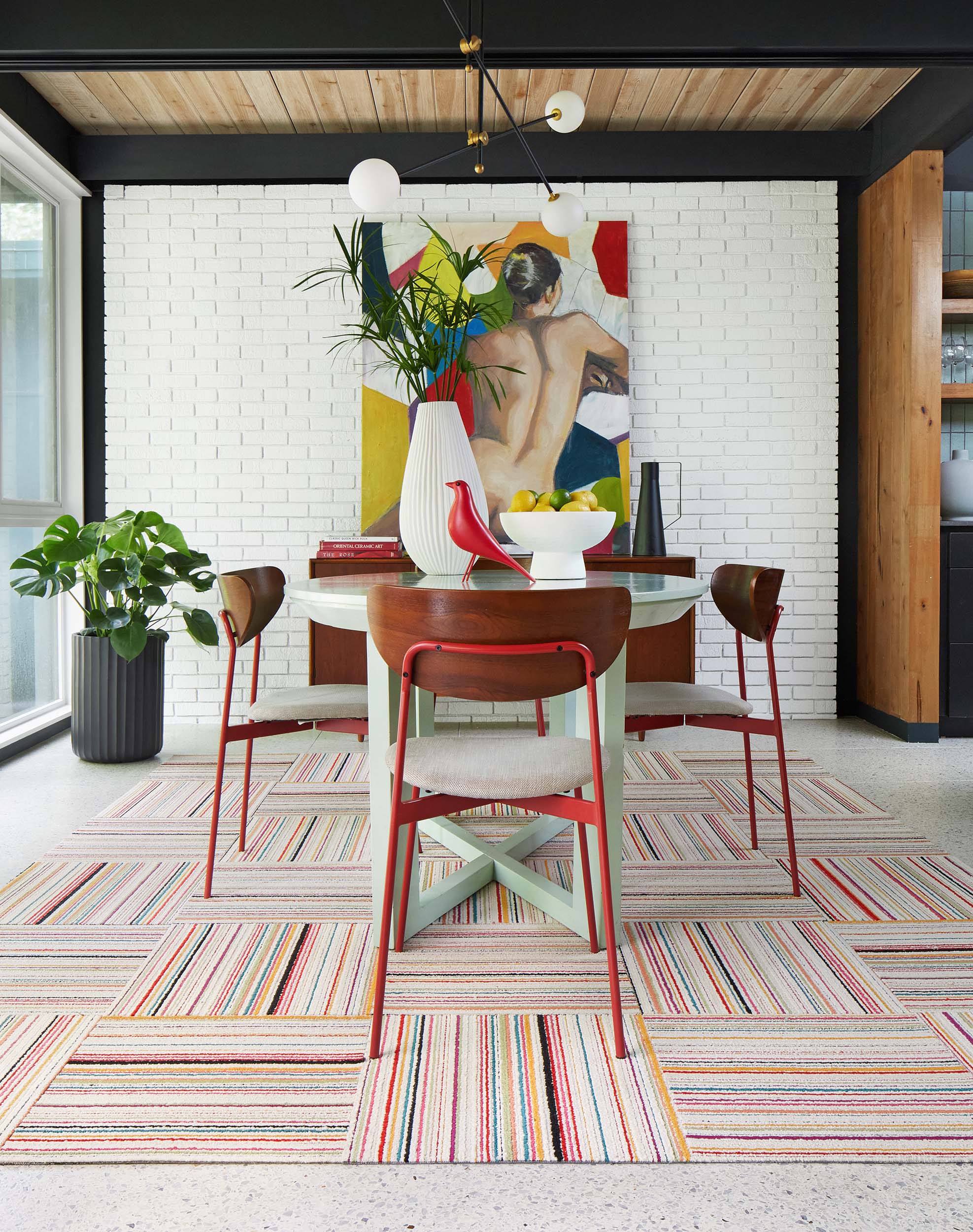
Blending traditional and contemporary designs in your dining room can create a harmonious and inviting atmosphere. Color palettes play a crucial role in achieving this balance. Consider pairing a bold, modern area rug with a muted, classical color scheme for your dining furniture. This juxtaposition can highlight the rug as a statement piece while maintaining a cohesive look. Additionally, textures can enhance this mix; a plush, contemporary rug can soften the hard lines of traditional dining chairs, leading to a warm and welcoming environment.
When selecting the perfect area rug, think about the patterns and materials that embody both styles. Here are some tips to guide you:
- Choose intricate patterns reminiscent of heritage designs but in a fresh colorway.
- Look for rugs that blend traditional motifs with modern geometric shapes.
- Experiment with materials like jute or wool that fit both rustic and modern aesthetics.
To illustrate, the following table highlights some popular combinations:
| Traditional Element | Contemporary Counterpart |
|---|---|
| Oriental patterns | Geometric designs |
| Rich, warm hues | Pastel or bold color contrasts |
| Natural fibers | Sleek synthetics |
Rug Placement: Aligning with Your Dining Room Layout

When considering the optimal placement of a rug in your dining room, it’s essential to ensure that it complements the overall layout. A well-chosen area rug can visually define the dining space and create a cozy atmosphere. Take into account the size of your dining table and chairs, along with the room’s size. Here are a few tips to keep in mind:
- Size Matters: Ensure the rug extends at least 24 inches beyond the edges of the table to accommodate pulled-out chairs.
- Symmetry is Key: Align the rug with the table for a coordinated look, fostering balance in the space.
- Consider Traffic Flow: Position the rug where it won’t obstruct movement or create tripping hazards.
Rugs can also contribute to the dining room’s overall style while influencing how movement interacts with your space. A round rug beneath a circular table can soften harsh angles, whereas a rectangular rug can complement long or narrow tables. When selecting the right rug, think about these factors:
| Rug Shape | Best For |
|---|---|
| Round | Square or round tables |
| Rectangular | Long dining tables and narrow spaces |
| Square | Modern settings with proportional furniture |
Evaluating Versatility: Rugs for Dining Rooms and Beyond

When selecting a rug for your dining room, consider the myriad of ways it can enhance not just your dining experience but also the overall ambiance of your living space. A well-chosen area rug can create cohesion between furniture pieces, establish a focal point, and introduce warmth and texture. Opt for durable materials that withstand spills and foot traffic, as dining rooms are lively environments. Patterned designs can hide stains while adding character, whereas solid colors can offer a sleek and modern touch. Think of your rug as an integral piece that pulls together the décor in your dining area and seamlessly transitions into adjacent spaces.
Beyond the dining room, versatile rugs can effortlessly adapt to different settings, making them a perfect investment. For example, consider the following options:
- Multifunctional use: A rug that looks great in the dining area can transition into a cozy living space for gatherings.
- Complementing outdoor areas: Indoor/outdoor rugs provide durability and style for patio dining.
- Layering potential: Use smaller rugs atop larger ones in open-concept designs to delineate spaces.
This adaptability not only reflects your style but also offers meaningful versatility that can elevate your entire home, making the pursuit of the perfect area rug an enjoyable journey.
Customizing Your Rug: Exploring Bespoke Options
Rug Trends: Current Styles Shaping Dining Room Decor

In the ever-evolving world of interior design, area rugs have become pivotal in defining the atmosphere of a dining room. This season, natural fibers like jute and sisal are taking center stage, celebrating a return to organic aesthetics. These textures not only complement a variety of furniture styles but also bring warmth and an earthy feel. Alongside these materials, vintage-inspired patterns are making waves, merging nostalgia with modern elegance. Intricate florals and geometric designs in soft, muted colors create an inviting underfoot experience that harmonizes with contemporary dining room decor.
Furthermore, sustainability continues to influence buying choices, prompting a surge in eco-friendly rugs crafted from recycled materials. Homeowners are now prioritizing rugs that reflect both their style and ethical values. On the color spectrum, deep, rich hues such as emerald green, navy blue, and burnt orange are trending, making bold statements while enhancing cohesiveness in a room’s palette. Here’s a quick look at the current popular styles shaping dining room spaces:
| Style | Description |
|---|---|
| Natural Fiber | Organic textures that promote warmth and sustainability. |
| Vintage-Inspired Patterns | Timeless designs that bring an air of nostalgia. |
| Eco-Friendly | Rugs made from recycled materials for the environmentally conscious. |
| Bold Colors | Rich, vibrant shades making striking statements in decor. |
Personal Touches: Adding Customized Elements to Your Rug
Creating a dining room that reflects your personal style goes beyond choosing the right furniture and decor; it’s about infusing elements that speak to who you are. Customized area rugs serve as a fantastic canvas for expressing individuality. Here are some ideas to personalize your rug:
- Monogramming: Add your initials or family name to the rug for a distinctive touch.
- Color Palette: Select colors that complement your dining room’s theme and mood.
- Pattern Selection: Choose patterns that resonate with your style, whether it’s whimsical florals or geometric designs.
- DIY Options: Consider hand-painted or stenciled elements for a truly unique rug that showcases your creativity.
Combining function with personalization enhances not just the aesthetic but also the emotional connection to your dining space. A distinctive rug can bring harmony to the room by tying together colors and styles, while also offering a tactile experience for guests. Below is a simple representation of how personalized elements can transform a standard rug into a masterpiece:
| Rug Feature | Impact |
|---|---|
| Custom Size | Perfect fit for your dining area, enhancing flow. |
| Unique Textures | Offers depth and comfort underfoot, inviting interaction. |
| Thematic Motifs | Reflects cultural or personal interests, sparking conversation. |
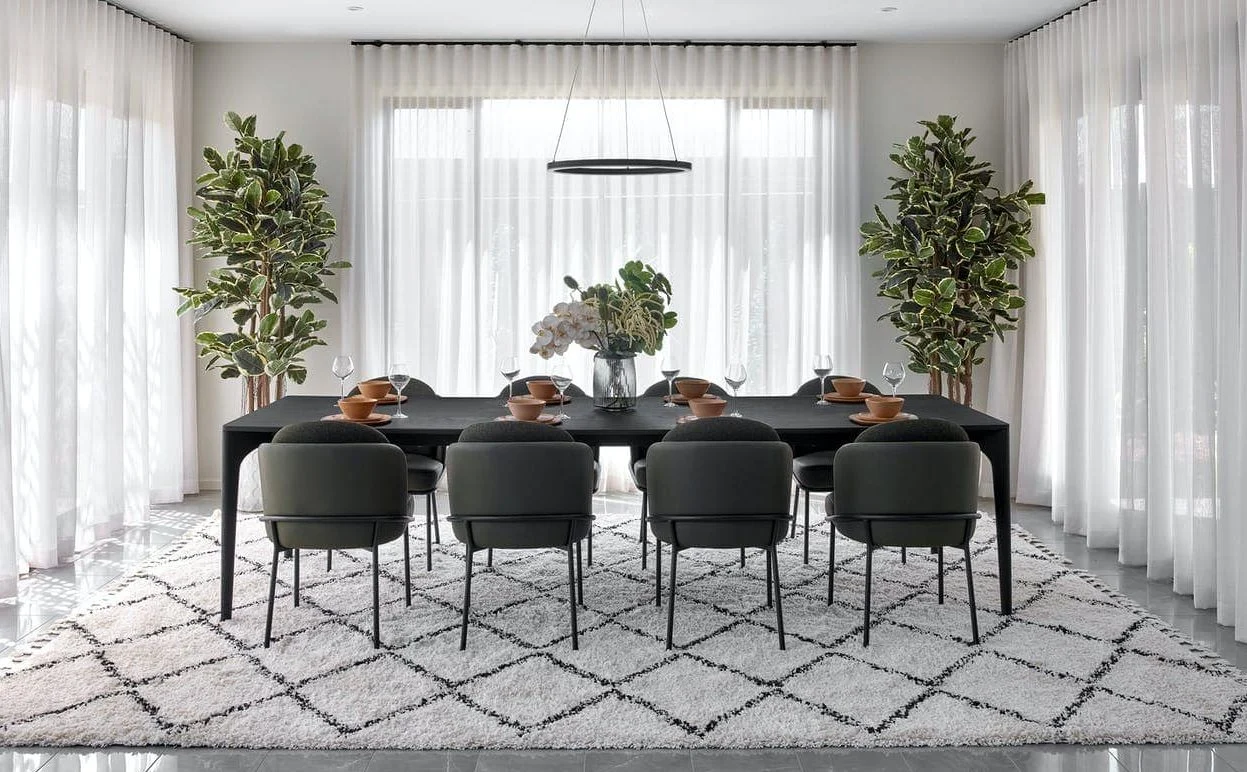
Q&A
Q&A: Enhancing Your Space with the Perfect Dining Room Area Rugs
Q1: Why should I consider using an area rug in my dining room?
A1: An area rug can transform the overall aesthetic of your dining room, adding warmth and texture. It helps define the space, making it feel more inviting and cohesive. Additionally, a well-chosen rug can absorb sound, making mealtime conversations more pleasant.
Q2: What size rug is ideal for a dining room?
A2: The ideal rug size depends on your dining table and the accompanying chairs. As a general rule, aim for a rug that extends at least 24 inches beyond the edges of the table to ensure that chairs can be pulled out comfortably without catching on the rug’s edge. A proper fit creates a harmonious look while enhancing functionality.
Q3: How do I choose the right material for my dining room rug?
A3: When selecting a material, consider durability and ease of cleaning. Natural fibers like wool and cotton are soft and have a luxurious feel but require more care. Synthetic options like polypropylene and nylon are stain-resistant and easier to maintain, making them ideal for high-traffic areas. Ultimately, your choice should align with your lifestyle and aesthetic needs.
Q4: What patterns and colors should I look for when choosing a rug?
A4: The possibilities are endless! If your dining room has a neutral palette, consider rugs that incorporate bold colors or striking patterns to create a focal point. Conversely, if your space is already vibrant, a subtle, textured rug can add depth without overwhelming the decor. Remember to think about how the rug will harmonize with your existing furniture and style.
Q5: Should I prioritize comfort or style when selecting an area rug for my dining room?
A5: Ideally, you should find a balance between comfort and style. While you want your rug to look beautiful and complement your design scheme, it should also be comfortable underfoot, especially if you’re hosting long meals. Select a plush option that feels good as you walk on it, while still enhancing your room’s overall visual appeal.
Q6: How can I care for my dining room rug to maintain its appearance?
A6: Regular maintenance is essential for prolonging the life of your rug. Vacuum it weekly to prevent dirt buildup, and promptly address spills with appropriate cleaning methods. For deep cleaning, consult the manufacturer’s care instructions. Depending on the material, you may need to rotate the rug occasionally to avoid uneven wear and fading.
Q7: Can I use a dining room rug in a multifaceted space?
A7: Absolutely! In open-concept areas, a dining room rug can serve as an effective visual separator, defining the dining space from adjacent living areas. Just ensure that the rug complements the surrounding decor, creating a seamless transition that ties the entire room together.
Q8: What are some common mistakes to avoid when choosing a dining room area rug?
A8: One of the most common mistakes is selecting a rug that is too small—making the space feel disjointed. Another error is choosing a light-colored rug for a high-traffic dining area, which can quickly show stains. Lastly, overlooking the importance of texture can result in a flat look, so incorporate variety for a more dynamic space.
With these tips and insights, finding the perfect dining room area rug can enhance not just your space, but also your dining experience. Happy decorating!
In Conclusion

In the grand tapestry of home design, the dining room holds a special place where we gather to share meals, laughter, and memories. By choosing the right area rug, you not only define the space but also enhance the overall ambiance, creating a warm and inviting atmosphere that welcomes family and friends alike. As you embark on the journey to transform your dining area, consider the interplay of color, texture, and size to find the perfect rug that resonates with your style and elevates your dining experience. Whether it’s a bold statement piece or a subtle complement to your décor, the right rug can tie the room together, making every meal a memorable occasion. So, take your time, explore your options, and let your dining room reflect the essence of who you are. After all, the perfect rug is more than just an accessory; it’s the foundation of your dining experience.
As an Amazon Associate I earn from qualifying purchases.
